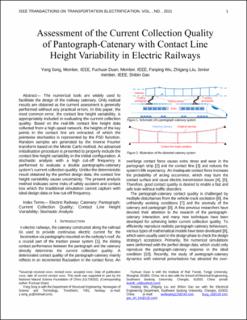| dc.contributor.author | Song, Yang | |
| dc.contributor.author | Duan, Fuchuan | |
| dc.contributor.author | Wu, Fanping | |
| dc.contributor.author | Liu, Zhigang | |
| dc.contributor.author | Gao, Shibin | |
| dc.date.accessioned | 2021-11-16T09:38:40Z | |
| dc.date.available | 2021-11-16T09:38:40Z | |
| dc.date.created | 2021-11-12T12:46:22Z | |
| dc.date.issued | 2021 | |
| dc.identifier.issn | 2577-4212 | |
| dc.identifier.uri | https://hdl.handle.net/11250/2829768 | |
| dc.description.abstract | The numerical tools are widely used to facilitate the design of the railway catenary. Only radical results are obtained as the current assessment is generally performed without any practical errors. In this paper, the most common error, the contact line height variability, is appropriately included in evaluating the current collection quality. Based on the real-life contact line height data collected from a high-speed network, the heights of the key points in the contact line are extracted, of which the pointwise stochastics is represented by the PSD function. Random samples are generated by the inverse Fourier transform based on the Monte Carlo method. An advanced initialisation procedure is presented to properly include the contact line height variability in the initial configuration. A stochastic analysis with a high cut-off frequency is performed to evaluate a double pantographs-catenary system’s current collection quality. Unlike the deterministic result obtained by the perfect design data, the contact line height variability causes uncertainty. The present analysis method indicates some risks of safety accident and contact loss which the traditional simulation cannot capture with ideal design data or low cut-off frequency. | en_US |
| dc.language.iso | eng | en_US |
| dc.publisher | Institute of Electrical and Electronics Engineers (IEEE) | en_US |
| dc.title | Assessment of the Current Collection Quality of Pantograph-Catenary with Contact Line Height Variability in Electric Railways | en_US |
| dc.type | Peer reviewed | en_US |
| dc.type | Journal article | en_US |
| dc.description.version | acceptedVersion | en_US |
| dc.rights.holder | © IEEE. Personal use of this material is permitted. Permission from IEEE must be obtained for all other uses, in any current or future media, including reprinting/republishing this material for advertising or promotional purposes, creating new collective works, for resale or redistribution to servers or lists, or reuse of any copyrighted component of this work in other works. | en_US |
| dc.source.journal | IEEE Transactions on Transportation Electrification | en_US |
| dc.identifier.doi | 10.1109/TTE.2021.3090477 | |
| dc.identifier.cristin | 1954084 | |
| cristin.ispublished | true | |
| cristin.fulltext | postprint | |
| cristin.qualitycode | 1 | |
